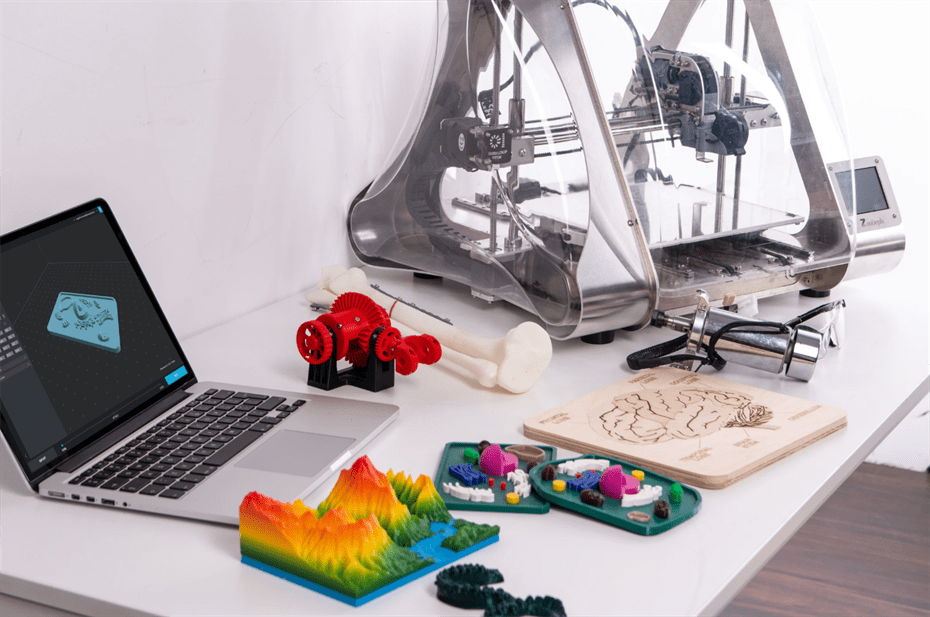Pressing a button to produce just about any object that springs to mind seems like the stuff of science fiction. But thanks to 3D printing, this is no longer a futuristic idea — it’s cutting edge technology that is transforming many industries, from manufacturing all the way to healthcare.
What is 3D printing?
British chemist David E.H. Jones was the first to theorize the possibility of using monomers to build solid objects in 1974. However, it wasn’t until a decade later that American inventor Chuck Hull came up with the first working commercial 3D printer. Building on that earlier idea, Hull used ultraviolet light to fashion an object out of photopolymers, until each layer solidified.
Hull’s original invention is not too dissimilar to modern 3D printers. Also called additive manufacturing, 3D printing is the process of making 3D objects with a specialized 3D printer. But just like an average printer, input from a user is needed — in this case, a digital design uploaded to a modeling software — to create an output.
Other than the digital file and the 3D printer itself, you also need raw materials or “ink” for your printer. The list of filaments that can be used for 3D printing is growing, and tech journalist Richard Baguley notes that there are of course pros and cons to each of them. For instance, one of the cheaper options, polylactic acid (PLA), is easy to print with and eco-friendly, but the final products are known to deteriorate over time. On the other hand, carbon fiber filaments are ideal for creating sturdy yet lightweight products. This, however, requires carbon fiber 3D printers, as well as specialized experience in manufacturing.
After preparing all of the above, all that’s needed is to press a button and wait. The 3D printer will extrude (or squeeze out) the filaments to add one layer on top of another — hence the term additive manufacturing — until your desired product is finished.
How is it used today?
From mass-producing automotive parts to creating packaging for beauty products, senior technology analyst Dr. Bryony Core points out how 3D printing is making manufacturing processes more cost-effective. Given that the process is cheaper and less time-intensive, 3D printing leaves room for mass customization, meaning consumers’ wants and needs are taken into consideration without sacrificing economies of scale.
This is crucial for industries like healthcare, as it ventures into the fabrication of cells and tissues — a technology known as bioprinting. This application is being used to create artificial organs, which can be the key to solving problems such as the distinct lack of organs available for transplants. Its other uses include tissue regeneration and cosmetic surgery, both of which require high levels of personalization.
The world may also be one step closer to solving global homelessness with 3D printing. Just last year, housing non-profits New Story and Echale partnered with 3D printing company ICON to develop a neighborhood for homeless families in Mexico. The project, already underway, will have 50 families living in their own 3D printed homes. This goes to show that 3D printing is capable of large-scale projects, like the construction of houses that can bring new hope to families in need.
But 3D printing can also impact even the tiniest and most intricate manufacturing processes that shape our lives on a daily basis. Altium explains how making a PCB with a 3D printer has changed this particular process for the better. PCBs are the little green circuit boards that make all of our electronics work. The 3D printing process can reduce costs, speed up production times, and standardize different designs — benefits that industries working with increasingly intricate electronics can enjoy.
Whether it’s for manufacturing vital electronic parts, organs, or villages, it’s undeniable that 3D printing is a major game-changer for various sectors. It will be exciting to see the tech make waves in bigger and more ambitious projects in the future. And for more stories on the latest in the tech space, be sure to check out other Tech Newz articles.
